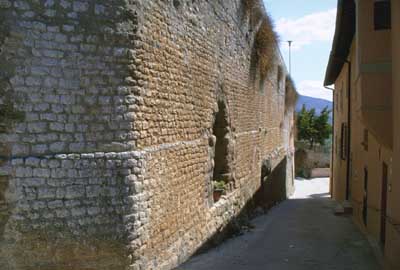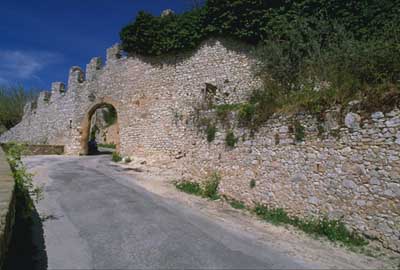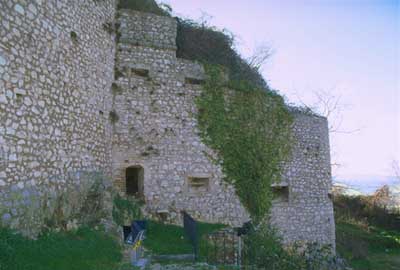|
| ||||
| The walls of Trevi are nearly intact. Both route and
construction material clearly differentiate the original fortification (the
castrum or Roman fortified camp) from its medieval enlargements.
The oldest part of the walls comprises those that still today form the boundary of the town to the west; very substantial remains can also be seen, however, in the Via del Fiscale, the Via Fantosati and in the last stretch of the Via S. Francesco. The remainder of the walls has been incorporated into later buildings, and in the deeper recesses of certain houses vestiges of them can be clearly identified: above the Via S. Francesco, in the Via della Fonderia and in the compound of the former monastery of S. Bartolomeo. |
 |
|
| A powerful Roman work datable to the 1c B.C., these walls form a more or less circular circuit around the top of the hill, or to put it better, a polygonal enclosure with something like 16 to 18 sides. Built as a compact curtain wall, it is of variable height depending on the terrain, and about two meters thick at the base; it has neither loopholes nor towers. | ||
 |
The material used, a solid local limestone and a lime mortar
produced by heating that same stone, has so firmly amalgamated under the
effect of rainwater that in some places one can no longer tell where the
stone ends and the mortar begins.
Three gates have been identified as part of the Roman wall. The main square — now called Piazza Mazzini — was outside the walls, as is rather frequently the case with very ancient fortified towns. The first medieval extension of the walls was toward the east, in order to take in, precisely, the area of the piazza all the way through to the flat space that now forms the Piazza Garibaldi, where a moat (the "Lago", literally the Lake) was dug to defend the more vulnerable parts of the wall. |
| Around the mid-thirteenth century two further extensions, southwestward toward the valley, gave the town of Trevi the shape it still has today. All the damage done to the walls was the work of the century just now behind us. The most important of the vanished segments faced onto the Piazza del Mercato (today's Piazza Garibaldi) and was demolished in 1910, whereas the breach on the south side was made in the 70's in order to allow car access to the Piaggia neighborhood. Another small breach also opened up at about that time: the old gate of S. Fabiano, which had stood unused since time immemorial, finally collapsed through neglect, and was then despoiled of its stone. | ||
| But this complex monumental work, on the construction and maintenance of which great care has been lavished by the people of Trevi over the centuries, now requires a systematic plan of both routine and special maintenance, if the normal wear and tear of time and the deplorable effects of human neglect are to be prevented from causing it to be irretrievably lost within a very few decades. |  |
|
HOME Back to the MONUMENTS page
Translated by Bill Thayer ©2010
101
|
Associazione Pro Trevi - I-06039 TREVI (PG) E-mail: protrevi@protrevi.com © 1996-2023 by F. Spellani |
Grafica e gestione: Explica s.r.l. Aggiornamento: 27 aprile 2017. |